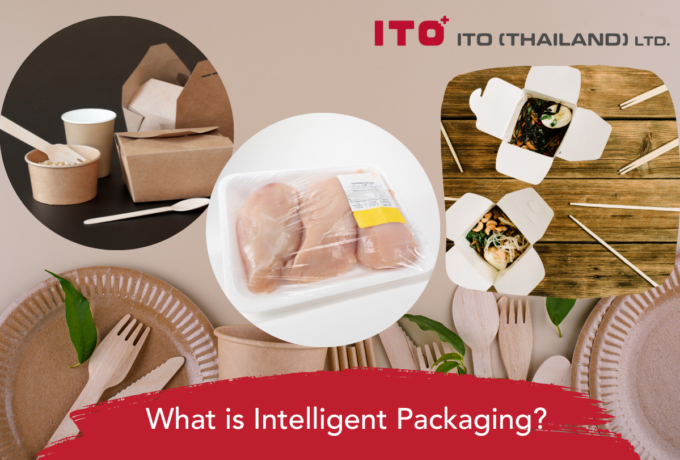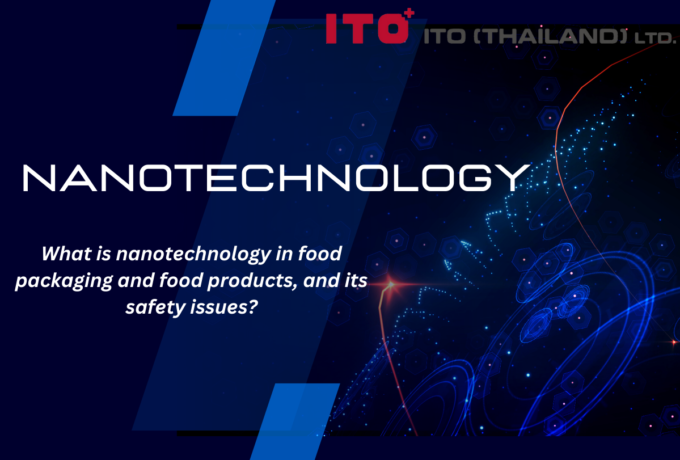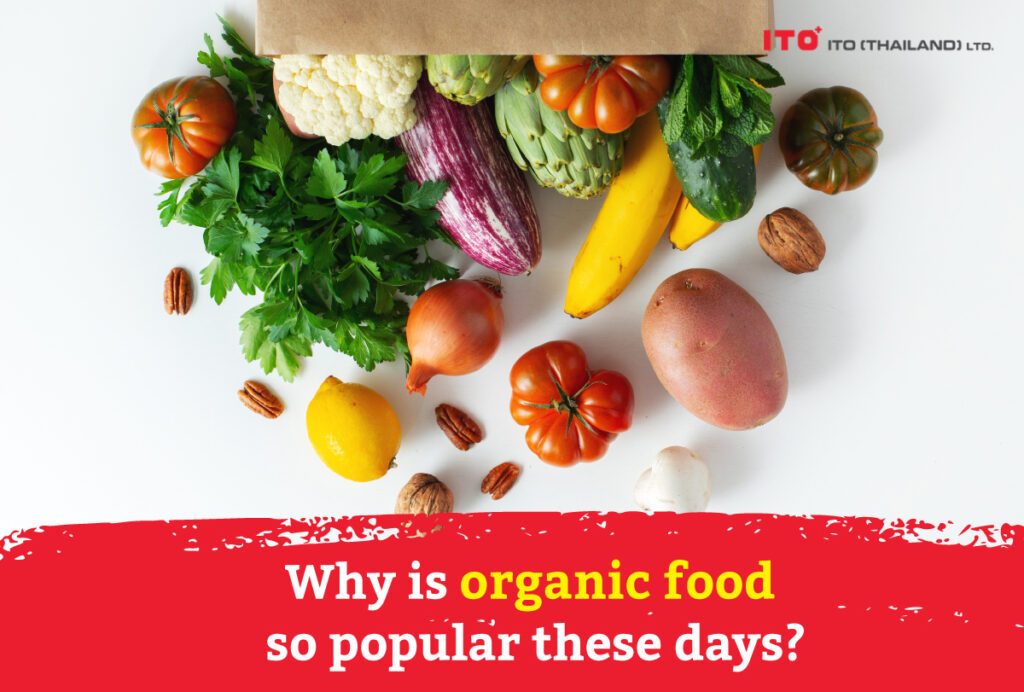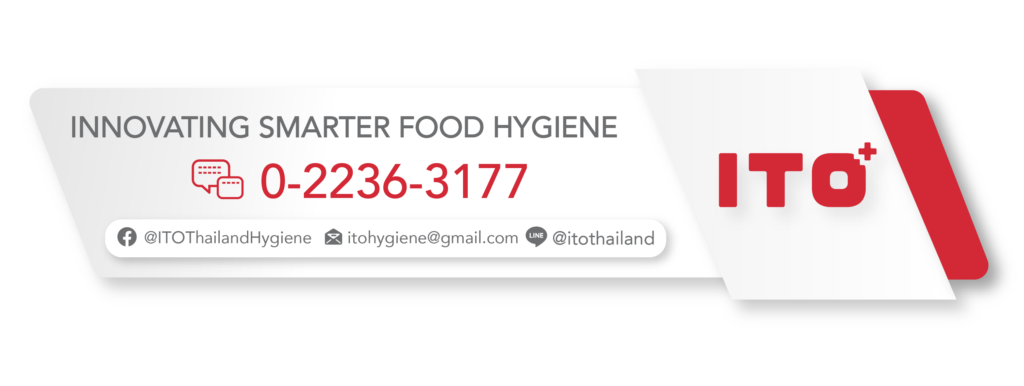ITO Thailand Hygiene Blog
Organic Food
Organic food is the food including plant-based and animal-based products, nuts, milk, eggs, etc., which are produced without using the synthetic chemicals such as pesticides, chemical fertilizers and not genetically modified organisms (GMO). Usually, organic food is not required to be 100% chemical free, but may have fewer chemical residues than conventional products. Also, it may contain the natural pesticides [1]. The substances that are commonly found include:
1.Pyrethrins [2] are extracts from flowers that help get rid of mosquitoes and flies which are harmless to humans. Mostly, they will cause only mild irritation and are approved for use in organic farming.
2.Oil [3] is commonly used as a substitute for pesticides and fungicides because it is safe for consumption.
3.Copper sulfate [4] is commonly used as a fungicide substitute approved by the United States Department of Agriculture (USDA). However, use in volume may cause harm to humans such as skin irritation, eyes irritation, etc.
Organic food consumers will receive the amount of nutrients, vitamins and minerals not different from those of non-organic foods. However, the organic food will be less contaminated with synthetic chemical substances and pesticides. Therefore, it can be said that organic food is consumed to reduce the accumulation of undesired substances for long-term health. Besides, the organic food has less impact on the environment and has used the renewable energy in production, as well as, the ethical treatment of farm livestock due to animals are raised in open areas and not received the chemicals such as growth hormone, steroids, antibiotics, etc.
International certification of organic food
The organic standards are designated for the consumers to be able to choose to buy the organic food products with confidence according to the rules of different countries by displaying the mark on the packaging, for example:
1.USDA Organic Standards [5] for USA organic products are divided into plant-based, animals, processed products and wild plants. The logos displayed on the packaging are divided into four categories, depending on the percentage of organic ingredients and packaging characteristics including 100% Organic, Organic, Made with Organic ______, Specific Organic Ingredient Listings.
2.Australian Certified Organic Standard (ACOS) [6] for Australia has the criteria for percentage of organic ingredients similar to those of the United States. In addition, ACOS is also European Union certified.
3.The Organic Logo [7] for the European Union has the symbol of the constellations arranged in leave shape on a green background. For organic food products that are produced, sold and packaged for sale in the European Union or imported goods, they must comply with EU regulations, etc. The food products that can use this logo must contain at least 95% of organic ingredients.
The relevance of organic food to the Thai food industry
Nowadays, the organic food market has undeniably great value. According to the assessment data of Kasikorn Research Center (August 2018) [8], the organic food market was found worth as high as 2,700 -2,900 million baht and these figures will be higher due to the increasing trend of consumer behavior that chooses to eat healthy food including the sustainable agriculture and livestock farming that have been supported by various governments.
In addition, in “THAIFEX – Anuga Asia”, the largest food and beverage trade show in the Asia-Pacific region which is held annually with more than 2,500 exhibitors from 40 countries having more than 60,000 participants throughout the period of 5 days, there is an “Organic Market” zone showing that this market is interested by the consumers. It is estimated that the demand for organic goods in this region will account for more than 12% of global revenues by 2025 [9].
However, the main obstacle to the growth of the organic food market is the prices of organic products are higher than those of the conventional products in the market due to higher production costs including meticulous quality control resulting to inability to reach all groups of consumers.
The next important step is the development of product manufacturing technology, the research and improvement of product quality assurance system and the use of automated machines to reduce labor costs including the government policies to support relevant agencies which will result to positive effects on entrepreneurs to be able to sell organic foods at lower prices and easier accessible to consumers, as well as, leverage the quality standards of Thai products for export to meet the regulations of various countries.
References
1.Better Health Channel. Organic food [Internet]. 2020 [Cited 18 Apr 2022]. Available from https://www.betterhealth.vic.gov.au/health/healthyliving/organic-food
2.Bond, C.; Buhl, K.; Stone, D. 2014. Pyrethrins General Fact Sheet; National Pesticide Information Center, Oregon State University Extension Services. http://npic.orst.edu/factsheets/pyrethrins.html
3.E. Bogran, Scott Ludwig and Bradley Metz. Using Oils As Pesticides [Internet]. 2022 [Cited 18 Apr 2022]. Available from https://agrilifeextension.tamu.edu/library/farming/using-oils-as-pesticides
4.Andrew Porterfield. Viewpoint: Organic fungicide copper sulfate and other copper products widely used by wine growers endangers humans, animals and insects [Internet]. 2020 [Cited 18 Apr 2022]. Available from https://geneticliteracyproject.org/2020/07/23/organic-fungicide-copper-sulfate-poses-dangers-to-humans-animals-insects-how-does-it-compare-to-conventional-pesticides
5.USDA Agricultural Marketing Service. About Organic Labeling [Internet]. 2022 [Cited 19 Apr 2022]. Available from https://www.ams.usda.gov/rules-regulations/organic/labeling
6.Australian Organic. Australian Certified Organic Standard [Internet]. 2022 [Cited 19 April 2022]. Available from https://austorganic.com/industry/certification-and-standards/standards/acos
7.European Commission. The organic logo [Internet]. 2022 [Cited 19 Apr 2022]. Available from https://ec.europa.eu/info/food-farming-fisheries/farming/organic-farming/organic-logo_en
8.K SME Analysis. ตลาดออร์แกนิค ธุรกิจสร้างเงิน SME ไทย [Internet]. 2018 [Cited 18 Apr 2022]. Available from https://www.kasikornbank.com/th/business/sme/KSMEKnowledge/article/KSMEAnalysis/Documents/Thai-SME_Organic-Product.pdf
9.THAIFEX-Anuga. THAIFEX – Anuga Organic Market [Internet]. 2022 [Cited 19 Apr 2022]. Available from https://thaifex-anuga.com/en/event-highlights/thaifex-anuga-organic-market
Related Post
-

Biodegradable Packaging
As straightforward as its name, it means any packaging that will naturally fall apart and decompose. In recent years, biodegradable packaging has been included as one of the sustainable development goals for several organisations. A similar issue, bioplastics, an alternative to sustainable living, was discussed in a previous blog. However, there are some differences between them. For example, bioplastics are made from raw materials sourced from renewable and natural sources and could or could not be biodegradable. In contrast, biodegradable plastic can naturally degrade through living organisms no matter the source material it originates from. The development history of biodegradable packaging, frequently used materials, the pros and cons of biodegradable packaging, and its future trends will be discussed in this blog.
-

Precision Agriculture
Precision agriculture has revolutionised how we approach crop management by optimising the inputs to meet specific requirements. Even though it is not a new system, recent technologies have made it possible to apply it in practical productions. In this blog, we will discuss the definition of precision agriculture, its pros and cons, and future trends.
-

Vertical Farming
Agriculture has utilised nearly all the available land, causing growing difficulty in finding land on the earth’s surface. With limited resources, meeting the world’s food demands will require more innovative and dependable methods of producing safe food, and the answer lies in vertical farming.
-

Intelligent Packaging
Without packaging, food products would last for only a short period of time, impossible for logistics management, difficulties in the supply chain system, quick quality deterioration, and prone to contamination to risky foodborne pathogens. In reality, there are many more functions that packaging is contributing to food products, as well as many types of smart packaging. Intelligent packaging is considered to be a part of smart packaging, so in this blog, we will discuss the contribution of intelligent packaging to food products.
-

Robots & automation in the food industry
Entering a new era in the food industry with robotics and automation in the food industry
-

Nanotechnology in the Food Industry
Nanotechnology has been brought to our attention for the last decades, and it has provided various beneficial applications to the food industry. Unlike other technology, nanotechnology has broadened the knowledge in the food industry to another level in a nanoscale dimension. It involves almost every aspect of the food industry, including food packaging, food processing, as well as functional food development and enhancement of food safety. In this blog, we will discuss how nanotechnology is used in food packaging and food products, and the most important part, its safety issues.










